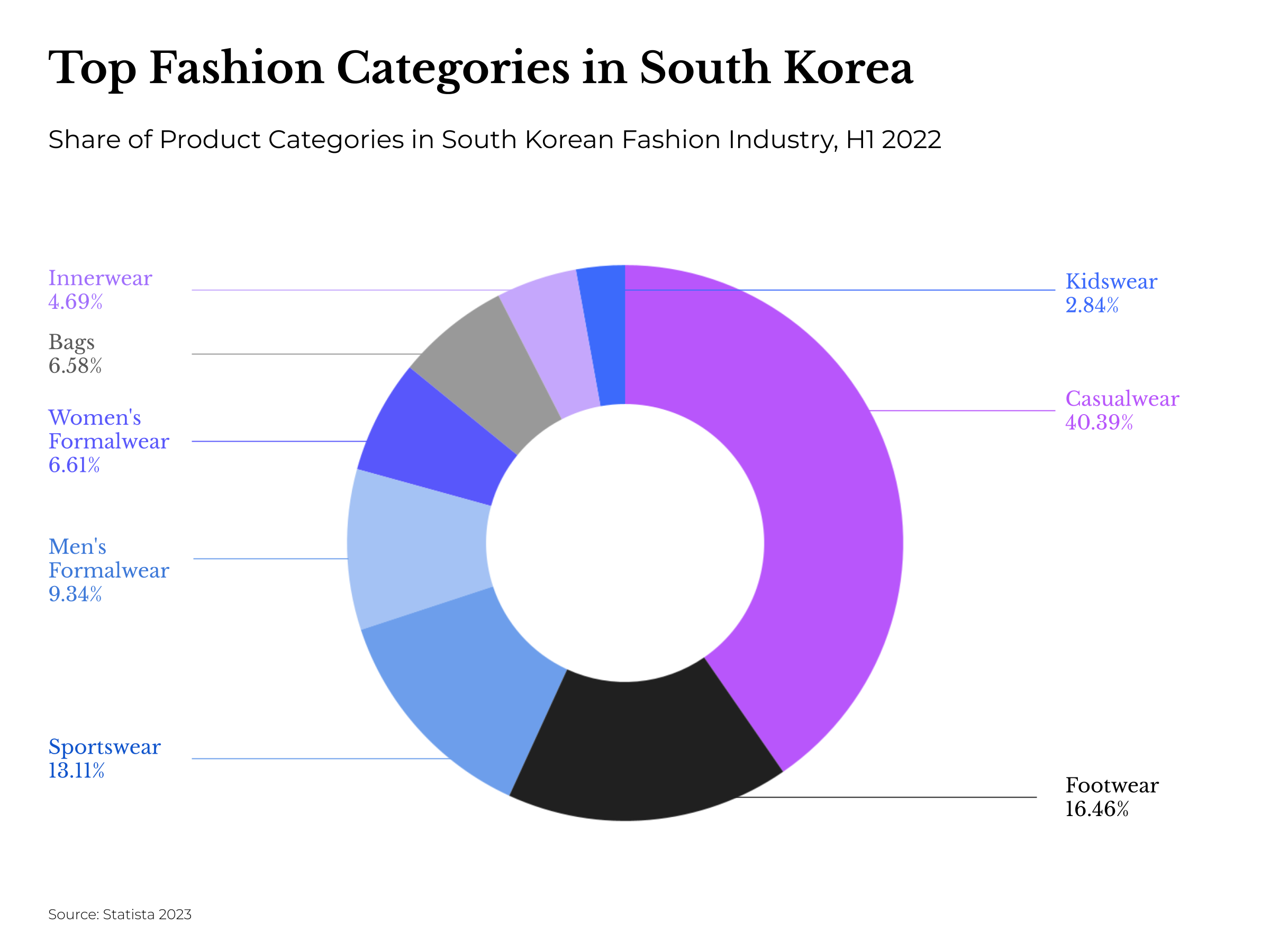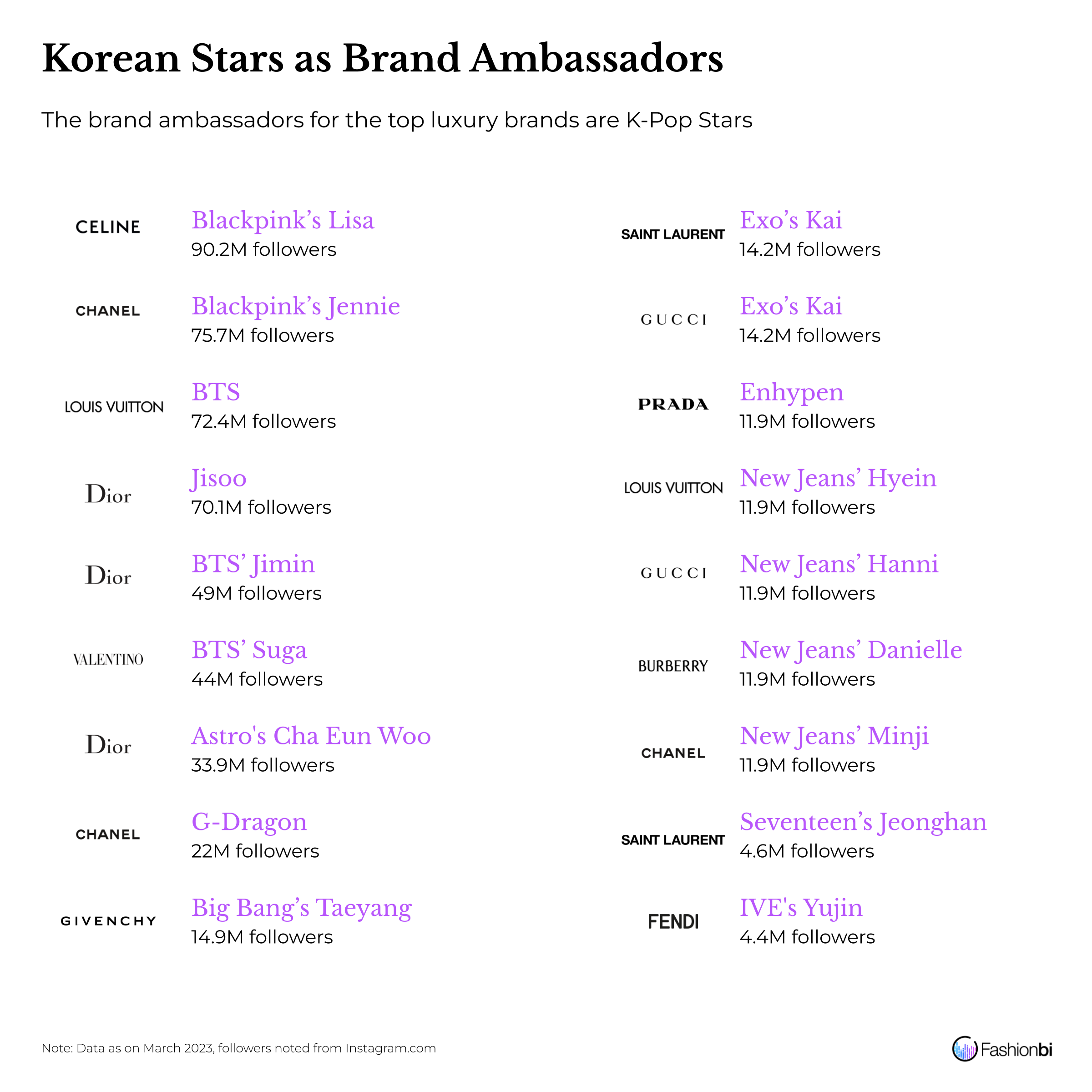It was also reported that the country became the largest consumer of luxury goods per capita, overtaking the US and China. The reason for this was the direct entry of many international brands into South Korea. Another reason is the rise in popularity of K-Pop around the globe, and international brands tying up with K-Popstars to take advantage of this phenomenon.
In 2022, the luxury market in South Korea grew by 24% versus 2021, reaching US$ 16.8 billion (approximately 20.9 trillion won). On a per capita basis, South Koreans earn more than US Americans ($280, about 340,000 won) as well as more than the Chinese ($55, about 68,000 won).
As per Euromonitor, the luxury goods market in South Korea was worth 19,448.8 billion won in 2022, an 8.1% increase from 2021.
International Fashion Brands in South Korea
In the 1980s, the fashion industry in South Korea had a boom due to importing of international brands such as Nike, Prospects and Levi’s. Brands such as Guess, Giorgio Armani and Calvin Klein became popular in South Korea during the 1980s. In the early 1990s, big department stores expanded their business by operating international brands. However, now there are also international brands that manage their business independently, such as Louis Vuitton and Nike.
Brands operating through agreement with local parties
There are local corporations such as Samsung, LG, Hyundai, Lotte which are family owned, and have strong ties with the local government, South Koreans call them Chaebol. All these Chaebols expanded their business into fashion. These corporations are not only developing local fashion brands, but they are also bringing international brands to South Korea.
- Shinsegae International (owned by Shinsegae group) manages over 40 international brands: Giorgio Armani, Acne, Alexander Wang, Chloe, Diesel, Marni, Céline, Dsquared2, Givenchy, Sacai, Brunello Cucinelli, Chrome Hearts, Christian Louboutin, Dries Van Noten, Stella McCartney, Gap, and others.
- Samsung Fashion C&T Fashion Group (owned by Samsung) carries both luxury and premium brands: 10 Corso Como Seoul, Balmain, Comme des Garçons, Rick Owens, Theory, Thom Browne, Issey Miyake, Canada Goose, Aspesi, Maison Kitsune, Rag & Bone, Tory Burch, etc.
- Handsome Group (owned by Hyundai group) carries 8 international brands: MM6, 3.1 Phillip Lim, Lanvin Paris, Ports 1961, Each x Other, The Kooples, Rochas and Club Monaco.
- LG Fashion LF Group carries premium brands: Vince, Birkenstock, Cole Haan, Jill Stuart, DAKS, FitFlop, Bensimon, Teva, D.A.T.E., Joseph, Pomandère and so on.
Brands that manage business independently
Brands such as Hermès, Chanel, Louis Vuitton, Prada, Gucci and Coach made direct entry and operate their business independently in South Korea.
Thom Browne recently announced the end of its partnership with Samsung C&T Fashion Group, which will officially be dissolved in July 2023.
Balenciaga products were exclusively sold by Handsome since 2005. However, they became independent after 2013.
Dolce & Gabbana were operated by Shinsegae in South Korea since 1997, but Shinsegae decided to end their partnership starting Fall/Winter 2019. Moncler ended the partnership in 2020 and started its own corporation in South Korea. Similarly, Celine has also parted ways with Shinsegae International towards the end of 2022, and launched itself independently in the beginning of 2023. Another brand that plans to do the same is Acne Studios, from Sweden.
OTB Group that owns Jil Sander, Diesel, and Maison Margiela has established a Korean corporation after the contract with Shinsegae International was terminated in 2022.
Other brands such as H&M, Zara, COS, Nike, Uniqlo, Fila, Adidas and Kappa also control their own operations in South Korea.
Since 2021, more than 8 luxury brands have ended their contracts with South Korean partners and decided to operate independently in the country.
Dongdaemun Market
The Dongdaemun area has served as a shopping center in Seoul since the 1900s. Starting from 1960, sewing factories were built in Dongdaemun. From 1970, South Korea started to export ready products. In 2000, online technology penetrated the fashion business, and as a result, online services started to appear in the Dongdaemun district, which led to the growth of South Korea’s online B2B (Business to Business) and B2C (Business to Customer) fashion businesses. Currently, Dongdaemun is one of the few wholesale fashion markets in the world that has a full-chain cluster of manufacturing factories and wholesale sellers in South Korea.
Design stage, sourcing of materials such as trims and fabrics, factories for sample making and construction, final production, and lastly the distribution network - all these 5 stages of value chain exist in Dongdaemun fashion area. There are 50,000 wholesalers operating in Dongdaemun, in 27 shopping centers.
Dongdaemun market has a shopping center not only for local citizens, but also for tourists who are interested in K-fashion. Because of Seoul’s deployment of an anti-missile system (THAAD), there was a huge decline in the number of Chinese tourists, and it also decreased online shopping. Nowadays, fashion malls in Dongdaemun market are developing new entertainment spaces.
Fashion Business Expansion for Local Companies
E-Land
In 2018, E-land fashion group penetrated a new market - the Middle East. The group launched its young casual wear brand MIXXO in Saudi Arabia and UAE. It was the first time a South Korean fashion brand launched business in the Middle East. Its portfolio brands include Mixxo, Spao, Cocinelle, Mandarina Duck and {New Balance}}.
Lotte Shopping generated 394.2 billion won ($312 million) in operating profit in 2022, up 89.9 percent as compared to 2021. Total Sales were worth 15.5 trillion won. Lotte department store is one of the main department stores in South Korea, which was established in 1979. There are 56 Lotte department stores including outlets in South Korea.
Handsome by Hyundai
Handsome, Hyundai’s Department Store fashion subsidiary, has opened its own shop in Galeries Lafayette department store in Paris, with a brand called SYSTEM for women and SYSTEM Homme for Men. This was the first time an Asian menswear brand was launched at the Galeries Lafayette department store. The brands available here are System, Lanvin, MM6 among others.
Handsome has introduced 'Home for Home' service for the first time in the industry, through its online mall TheHandsome.com. This provides O2O (Online to Offline) service, and allows customers to try out Handsome clothes at home before purchasing. Hyundai Department store is one of the three major department stores chains in South Korea.
Samsung
In 2015, Samsung C&T’s Fashion Group strengthened e-commerce via the partnership with China’s leading online player, Alibaba. Samsung C&T launched a new brand to Alibaba’s Tmall store, a casual clothing line called Eight Seconds. After this, other brands of Samsung C&T joined Eight Seconds on Tmall (brands like Juun J and KUHO).
Samsung C&T’s Fashion Group now has 32 brands, 1,179 stores with 5 global offices. It generated 1.6 trillion Korean won in sales in 2021.
Kolon Industries
In June 2018, Kolon Industries’ FnC fashion group joined hands with one of the largest Chinese online retailers - JD.com. Kolon Industries’ FnC launched its casual brand for the young generation, called Lucky Chouette, on JD.com. Lucky Chouette is a domestic brand loved by South Korean celebrities, and is well known in China.
E-commerce in South Korea
By the end of 2023, the ecommerce market in South Korea is projected to generate a revenue of US$109,842.0 million. It is predicted to grow at a CAGR of 3.6% between 2023 and 2027, and reach a market volume of US$126,427.0 million by 2027. From this, fashion is the largest market, accounting for 31.4% of the total revenue generated. COVID-19 has also been a big contributor towards ecommerce growth. Over 94% of South Koreans between 20 and 39 years of age engage in online shopping.
In order to reach sales goals and manage inventory, big department stores have sales (discounts) between October and November. MUSINSA, StyleShare and many other local e-commerce companies are adopting Farfetch and Yoox’s best practices to expand South Korean fashion online business.
Due to the advancement in technology, and increasing number of technology startups in South Korea, mobile e-shopping is becoming an important channel. New technological solutions for e-commerce companies and fashion tech startups are also rising in South Korea. MUSINSA and Cafe24 are important e-commerce case studies for many other companies nowadays.
B2B
- Godo provides a fashion focused e-commerce platform for other companies.
- Cafe24 provides a global e-commerce platform for other companies.
- Makeshop provides a fashion focused e-commerce platform for other companies.
B2C and C2C General
- Naver, South Korea’s number one search engine, also provides shopping channels for users. Naver is the go-to app for brand discovery.
- Coupang is the largest marketplace in South Korea, with an annual revenue of US$18.4 billion in 2021. The marketplace is similar to Amazon, and sells fashion items and beauty products among other categories.
- Gmarket was founded in 2000 and functions as a C2C marketplace.
- SSG.com is an e-commerce channel by Shinsegae International.
- GS Shop is South Korea’s first ever TV home shopping company and GSShop.com is their official e-commerce channel.
- Lotte.com was the first-ever online shopping retail website launched in South Korea, which launched in June 1996.
B2C Fashion
- W concept is an online fashion retail platform which carries both local and international designer brands.
- Brandi is a mobile shopping app where users can buy from bloggers and Instagram influencers.
- StyleShare is an online shopping store on which users can share their stylish outfits.
- MUSINSA is the most popular South Korean online fashion retail platform.
Tech Companies
- Playauto provides e-commerce management solutions.
- Forbiz provides e-commerce management solutions.
- Commerce lab is an IT professional company which serves and manages O2O platforms.
Influencer Marketing in South Korea
South Korea has 99% web penetration, and had sales worth $95.5 billion through e-commerce, which makes it one of the most developed e-commerce countries. Youtube is the platform of choice to gather influencer opinions for 70% of teenagers using Youtube. In fact, 86% of South Korean women use social networks to make a purchase decision. Facebook is the top platform for influencer marketing, with 32% of the influencers preferring the platform, while Instagram comes second at 24%. Smartphone users are using KakaoTalk, mainly for messaging purposes and discussing new products. 93% of South Korean internet users use this app. YouTube is also popular and used for brand exploration. YouTube ads had a reach of over 90% of South Korea’s total population in early 2022.
Influencers are an important part of marketing for fashion and beauty brands in South Korea, with 57% of them using them as a part of their marketing strategy. And this strategy pays well, since for every $1 invested in influencer marketing, brands make sales worth $6.50.
Kakao Talk, a messaging app that is the most popular communication app in the country, is used by western brands like Chanel, Calvin Klein, Burberry, Miu Miu, Michael Kors and others, and these brands have official accounts on the app. Increasing number of the South Korean fashion companies are actively adopting influencer marketing to reach consumers.
The rise of K-Popstars

